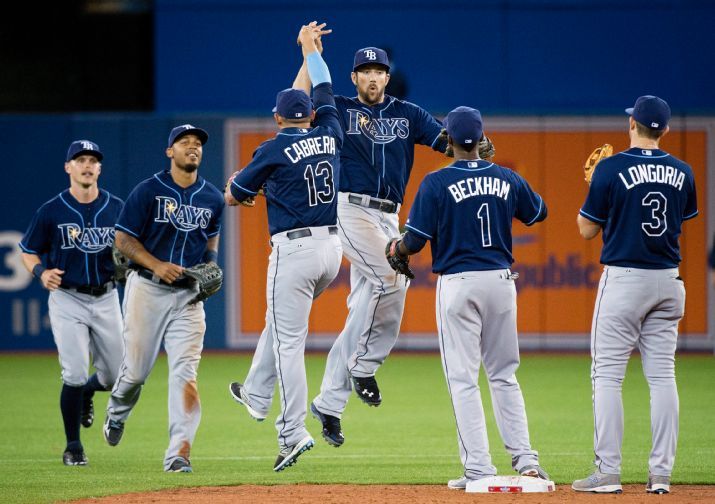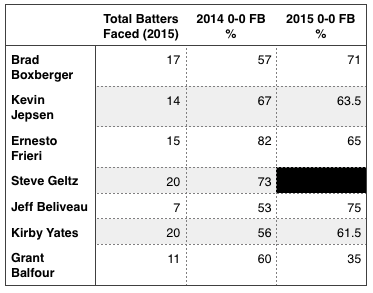
With the first week-and-a-half of play in the rear-view mirror, the 2015 Tampa Bay Rays have proven to be a somewhat confounding team. While the win/loss record might not indicate what we should expect out of the team over the next 152 games, we have learned a little about the Rays in the previous 10 games.
1. The Rays are fragile.
The Rays lead baseball in the number of players injured, with nine active players currently on the disabled list, some of which sustained injuries within the first three games of the season. These nine players account for more than a third of the payroll, per Marc Topkin.
Matt Silverman calls the situation “discouraging,” while clarifying “but we’re not discouraged.”
2. A walk is a hit.
What do Jennings, Longoria, Forsythe and Souza have in common? They’ve been rewarded with a good number of walks (at least four each) thanks to their patience in the batter’s box.
Sure, walks make for boring baseball, unless your thing is confounding pitcher. However, a fair number of their 28 total runs are due in part to the ability to work a quality at-bat. Besides, I cannot recall another team that scored six runs in one week, all via the bases loaded walk. The Rays are currently ranked second in walks, and in the top five in pitches seen per at-bat.
At the time of writing, the team slashed a combined .232 BA/.331 OBP/.397/.728 OPS/.323 wOBA line with 69 hits, 42 walks and three HBP. The current OBP leaders on the team are: David DeJesus, Brandon Guyer, Kevin Kiermaier, Evan Longoria, Steven Souza Jr., Logan Forsythe and Desmond Jennings.
3. The Rays can pitch…except when they can’t.
Tampa Bay improved from a 4.17 ERA and 3.45 FIP at the time I originally wrote this piece, to 3.48 ERA and 3.41 FIP. Yet they start the day with a 4.26 ERA and a 3.92 FIP, largely due to a pair of very poor starts by Erasmo Ramirez. That’s not to say the whole pitching staff is in peril, after all 65 strikeouts and a 7.28 K/9 are pretty good omens. While the pitching staff gave up five or more runs in four of the first nine games, shutouts by Jake Odorizzi and Chris Archer, combined with quality starts by Nathan Karns (among others) illustrate what this pitching staff can do when it is healthy and firing on all cylinders.
…Now to figure out what to do with Ramirez.
4. This team is resilient.
Despite losing games to the Orioles, Marlins and Blue Jays in contests that were initially blowouts, the Rays rallied to make things interesting. Moreover, they’ve shown a tendency to answer a team when it scores by adding to their own run total (see: the Rays performance in the Citrus Series).
Furthermore, this team is entertaining and fun again — something that can’t be said for the 2014 incarnation. Maybe it’s the powerful Steven Souza of defensively sound Kevin Kiermaier. Perhaps it’s the overall cohesive feeling the squad exudes or the slightly faster pace of play. Or maybe it’s all of the above, and then some.
5. A $70 million payroll is untenable (unless it isn’t).
Marc Topkin also reminded us on Sunday what we heard from the owner on the air in the opening series:
Principal owner Stuart Sternberg said the $70 millon-plus payroll is “an area beyond uncomfortable” and “puts us squarely in the red again.
According to Forbes Magazine, the Rays are currently worth $625 million (up 29% from 2014 – also last in MLB), having also accrued an estimated $188 million in revenue (also up from 2014). I’m not here to debate whether the team is or isn’t in the red.
Although with an increase in both team value and revenue, fused with the specter of a greater increase in revenue once a new TV contract is settled, the overall perception seems a bit contradictory.
6. This is no longer Joe Maddon’s team.
Topkin further detailed a few below the radar, yet very interesting, moves made by the Rays’ new regime:
A new team dress code requires collared shirts or a jacket over a T-shirt on travel days and no sneakers. Among other new-regime changes: players on the field for the anthem, and batting practice for day games.
Interestingly enough, manager Kevin Cash left the decision of road-trip attire to a handful of player representatives, including (but not limited to) Evan Longoria and Alex Cobb.
If the players indeed had a part in opting for a more professional approach to things, I can’t help but wonder what their level of appreciation for Joe Maddon’s hijinks may have been.
7. A new trend?
RJ Anderson (of the excellent Process Report blog) proposed an interesting hypothesis on April 9; some relievers appear to have increased their first-pitch fastball tendencies, while others have decreased their usage. I was intrigued by his hypothesis, yet the Rays only played three games at the time of his publishing. I wanted to see how the numbers panned out after gathering a larger sample size. Anderson looked at the first pitch fastball rates for Brad Boxberger, Kevin Jepsen, Ernesto Frieri, Steve Geltz, Jeff Beliveau, Kirby Yates and Grant Balfour (last season and now), and in kind I looked at the same group of hurlers.
Boxberger, Beliveau and Yates increased their usage of the first pitch fastball, while Jepsen, Frieri and Balfour seem to be depending upon their off-speed stuff more often to start an at-bat.
What does this mean? Anderson opines:
…It’s hard to ignore three fastball-first relievers suddenly leaning on their secondaries.
The reason this merits watching is because it wouldn’t be the first time the Rays instructed a pitcher to change his approach. Part of James Shields’ turnaround in 2011 is credited to his willingness to apply data from the front office to his pitching. He started using his curveball as a means to protect his fastball while stealing a strike. There have been other cases where a team-wide philosophy seems to be in play, too—same-handed changeups, elevated fastballs, and so on.
Those examples don’t prove the Rays are up to anything here; they just prove there’s a chance, however slim it may seem, that this is something more than a small-sample mirage.

